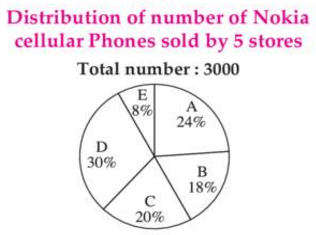
United India Insurance Co. Ltd. Assistant (Pre.) Examination Held on 22-9-2017
Reasoning
1. If the positions of the first and fifth digits in the number 24871369 are interchanged, similarly the positions of the second and the sixth are interchanged and so on, which of the following will be fourth from the right end?
(A) 2
(B) 7
(C) 1
(D) 9
(E) 5
Directions – (Q. 2-6) Read the information and answer the given questions-
C A 9 K 6 @ R U $ 7 Y 2 S % P H # N F Q 8 L X 1 € B W 3 T 4 D G
2. How many consonants are there in the above arrangement, such that each is preceded and succeeded by a number?
(A) None
(B) One
(C) Two
(D) Three
(E) More than three
3. How many symbols are between K and W such that it is both immediately preceded and immediately followed by a consonant?
(A) None
(B) Three
(C) More than three
(D) Two
(E) One
4. How many numbers are there in the above arrangement, each of which is immediately p receded by a consonant and immediately followed by a symbol?
(A) One
(B) Two
(C) None
(D) More than three
(E) Three
5. If all the letters are dropped from the above arrangement, which of the following will be tenth from the right end?
(A) $
(B) 6
(C) 2
(D) 9
(E) @
6. Which of the following is seventh to the right of twenty-first from the right end of the above arrangement?
(A) 8
(B) F
(C) 1
(D) W
(E) B
Directions – (Q. 7-11) Read all the information carefully and answer the given questions-
Seven students M, N, O, P, Q, R and S live on 7 different floors of a building. Lowermost floor of the building is number 1 and the one above that is numbered 2 till the topmost floor is numbered 7.
They belong to different countries i.e., India, Canada, Japan, China, Kenya, Poland and Austria but not necessarily in the same order.
Q belongs to Austria, P lives immediately below the one who is from Kenya and he is from China. R lives on an odd numbered floor and he is from Canada. S lives on 4th floor, Q lives just above M but not on 2nd floor. O lives on an odd numbered floor above 4th floor and he is from Japan. M doesn’t live on an even numbered floor. The one who is from Canada doesn’t live just below S’s floor. N lives on an even numbered floor. M is not from India.
7. Who among the following lives on 3rd floor?
(A) M
(B) N
(C) S
(D) P
(E) Q
8. Who among the following lives just above the one who is from India?
(A) M
(B) The one who is from China
(C) S
(D) O
(E) The one who is from Canada
9. Who among the following lives on 5th floor?
(A) Q
(B) S
(C) O
(D) M
(E) N
10. R belongs to which of the following country?
(A) Canada
(B) China
(C) Austria
(D) India
(E) Kenya
11. Who lives on topmost floor?
(A) Q
(B) M
(C) N
(D) O
(E) The one who is from Poland
12. Four of the following five are alike in a certain way based on a particular pattern and hence they are form a group. Which one of the following does not belong to that group?
(A) MON
(B) AGD
(C) LRO
(D) DHF
(E) PUR
13. In a certain code, ‘open the door’ is written as ‘ka te jo’, ‘door is closed’ is written as ‘Jo pa ma’ and ‘this is good’ is written as ‘la ra pa’. What is the code for ‘closed’?
(A) ma
(B) pa
(C) jo
(D) ka
(E) ra
14. How many such pairs of letters are there in the word INSTRUMENT, each of which has as many letter between them in the word as they have in the English alphabet?
(A) None
(B) One
(C) Two
(D) More than three
(E) Three
Directions – (Q. 15-19) Study the following information carefully and answer the given questions-
J, K, L, M, N, O, P and Q are sitting around a circular table at equal distance between each other, but not necessarily in the same order. Some of the persons are facing the centre while some are facing outside. (i.e. in a direction opposite to the centre)
Note: Same direction means that of one person is facing the centre then the other person is also facing the centre and vice-versa.
Opposite direction means that if one person is facing the centre then the other person is facing outside and vice-versa.
P faces the centre. N sits second to the right of P. K sits third to the left of N. N and K face opposite directions. Immediate neighbours of K face the centre. L sits second to the right of K. Q sits on the immediate left of L. J sits second to the left of M. M faces the same direction as K. M is not an immediate neighbour of P. Immediate neighbours of N face opposite directions. (i.e. if one neighbour faces the centre then the other neighbour faces outside and vice-versa.)
15. Who among the following sits third to the left of M ?
(A) Q
(B) O
(C) L
(D) J
(E) P
16. Who sits second to the right of J?
(A) P
(B) N
(C) L
(D) K
(E) Q
17. Which of the following is true regarding O as per the given seating arrangement?
(A) Q is one of the immediate neighbours
(B) O sits third to the right of N
(C) O faces the centre
(D) Only two persons sit between O and P
(E) Only one person sits between O and J
18. What is K’s position with respect to M?
(A) Second to the left
(B) Second to the right
(C) Third to the right
(D) Third to the left
(E) Fourth to the left
19. Four of the following five are alike in a certain way and hence form a group. Which one of the following does not belong to that group?
(A) M
(B) Q
(C) J
(D) P
(E) K
Directions – (Q. 20-22) Study the following information carefully and answer the given questions-
There are ten members A, B, C, D, E, F, G, H, I and J in the family. There are three generations of the family. There is also three married couple in the family. There is an equal number of male and female. A is the daughter-in-law of J. B’s brother I have only one sister. H and B are the married couple. H is the mother of C. G is the mother of B. D is the son-in-law of G. C is the sister of E. F is the only son of D.
20. If B is the son-in-law of X, then how is X related to C?
(A) Father
(B) Grandmother
(C) Grandfather
(D) Cannot be determined
(E) Brother
21. If Y is the daughter of I, then how is Y related to F?
(A) Sister
(B) Brother
(C) Sister-in-law
(D) Cousin
(E) Brother-in-law
22. If Y is the father of I then how is D related to Y?
(A) Son
(B) Daughter
(C) Son-in-law
(D) Brother
(E) Sister
Directions- (Q. 23 and 24) Study the given information carefully and answer the given questions-
Rahul starts walking towards East from Point G. He walks for 15 m and then takes a left turn. He then walks for 9 m and again takes a left turn. He reaches pint F after walking for 7 m. He takes a right turn, walks for 6 m and reaches point K. He finally stops at point S after walking for 8 m to the left of point K.
23. If Gokul 5 m North from point G, takes a right turn and stops after walking for 18 m. Then in which direction is point K, with respect to Gokul’s final position?
(A) South
(B) North
(C) South-east
(D) North-west
(E) East
24. How far is Point ‘S’ from Rahul’s starting point?
(A) 12 m
(B) 9 m
(C) 18 m
(D) 15 m
(E) 20 m
25. Pointing to the photograph of woman, Rohit said, “The woman in the photograph is the mother of the only daughter-in-law of my mother. “How is the woman related to Rohit?
(A) Aunt
(B) Wife
(C) Daughter
(D) Mother-in-law
(E) Daughter-in-law
26. How many such pairs of letters are there in the word FACEBOOK, each of which has the same number of alphabets between them (in both forward and backward directions) as in the English alphabetical series?
(A) One
(B) Two
(C) Four
(D) Three
(E) None
27. In a class of 35 students, Messi is 20th from left and Ronaldo is 20th from the right end. How many students are there between Messi and Ronaldo?
(A) 5
(B) 2
(C) 3
(D) 4
(E) 7
Directions – (Q. 28-32) In this question, two or three statements is given, which has 2 conclusion. You have to decide which conclusion follows the statement and answered as-
(A) Only conclusion I follows
(B) Only conclusion II follows
(C) Both conclusion I and II follows
(D) Either conclusion I or II follows
(E) Neither conclusion I nor II follows
28. Statements :
A ≤ R ≤ N = G ≥ T > S.
Conclusions: (I) A < S (II) A = S.
29. Statements :
C > R ≤ E = T; R < Y; U ≥ E
Conclusions : (I) C > Y. (II) U ≥ Y.
30. Statements:
P ≥ R = B ≤ S; C ≤ B > Z.
Conclusions: (I) Z = P (II) S ≤ Z.
31. Statements:
C > R ≤ E = T; R < Y; U ≥ E.
Conclusion: (I) U ≥ R (II) T ≤ U.
32. Statements: D ≤ Q < N ≥ W; Q > P
Conclusions: (I) P = D (II) N > P.
33. In a certain code language, the word ‘OPTIMUM’ is written as ‘UTPOMMI’. How will the word ‘BANKING’ be written in that code?
(A) NANKIGB
(B) NNKIGBA
(C) NABNIGK
(D) KANNGAB
(E) GABNNAK
34. If the first day of January is Tuesday what will be the fourteenth day of this month?
(A) Saturday
(B) Tuesday
(C) Friday
(D) Monday
(E) Sunday
35. If ‘%’ stands for addition, ‘*’ stands for subtraction, ‘−’ stands for division and ‘+’ stands for multiplication, then which of the following is true?
(A) 10 – 2%3 + 6 = 20
(B) 25 + 2%2 * 2 = 49
(C) 5 + 5 – 5 * 5 = 25
(D) 2 * 3%5 – 5 = 6
(E) 7%10 – 2 + 10 = 57





